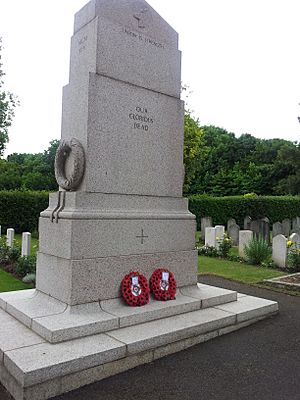South African War Memorial, Richmond Cemetery facts for kids
Quick facts for kids South African War Memorial |
|
|---|---|
| England, United Kingdom | |
 |
|
| For 39 South African soldiers who died at the South African Military Hospital in Richmond Park | |
| Unveiled | 1921 |
| Location | 51°27′25″N 0°17′12″W / 51.45690°N 0.28662°W Richmond Cemetery, Grove Road, Richmond, London
|
| Designed by | Sir Edwin Lutyens |
|
UNION IS STRENGTH, OUR GLORIOUS DEAD / EENDRAGHT MAAKT MACHT, ONZEN GEVALLENEN HELDEN
|
|
|
Listed Building – Grade II
|
|
| Official name | South African War Memorial |
| Designated | 24 July 2012 |
| Reference no. | 1409475 |
The South African War Memorial is a special monument in Richmond Cemetery in London. It remembers soldiers from South Africa who died during the First World War. This memorial was designed by a famous architect named Sir Edwin Lutyens. It looks like a tall, empty tomb, similar to the main Cenotaph in London, which Lutyens also designed.
A group called the South African Hospital and Comforts Fund Committee asked for this memorial to be built. It honors 39 South African soldiers. These soldiers sadly died from their injuries at a military hospital in Richmond Park during the war. General Jan Smuts officially opened the memorial in 1921. For many years, people from South Africa visited it. Later, it was not visited as much. In the 1980s, the Commonwealth War Graves Commission started taking care of it. Since 2012, it has been a special historic building, known as a Grade II listed building.
Why Was This Memorial Built?
During the First World War, a military hospital for South African soldiers was set up in Richmond Park. This park is right next to Richmond Cemetery. Sadly, 39 South African soldiers passed away at this hospital. They were then buried in Richmond Cemetery.
After the war ended, the South African Hospital and Comforts Fund Committee decided to build a memorial. They chose a part of the cemetery called "soldiers' corner," where the 39 South African graves are located. They asked Sir Edwin Lutyens to design it. Lutyens was a very important English architect. He had already designed the famous Cenotaph in London. That monument became a main place for national remembrance events. Lutyens also designed other war memorials, including one in South Africa. He worked a lot with the Commonwealth War Graves Commission to create memorials in war cemeteries.
Richmond Cemetery has many war memorials and graves. Near the South African Memorial, there is another section for soldiers from the Royal Star and Garter Home. This area has the Bromhead Memorial.
Design and History of the Memorial
The South African War Memorial is a type of monument called a cenotaph. A cenotaph is a monument that looks like a tomb but does not hold a body. This one is made from rough granite stone. Its design is based on the larger Cenotaph in Whitehall. It has a unique triangular top, which is different from most of Lutyens' other memorials. The base of the memorial spreads out and sits on two stone steps.
The memorial has two carved wreaths, one on each side. These are the main decorations. At the top of each side, there is a carved head of a springbok. A springbok is an animal that is a national symbol of South Africa.
The memorial has words carved into it in two languages: English and Dutch. On the side facing away from the graves, it says in English: "UNION IS STRENGTH / OUR GLORIOUS DEAD." Below this is a carved cross. On the other side, facing the graves, the same message is written in Dutch. The memorial also has the Roman numerals for 1914 and 1919 carved on its sides. These dates mark the beginning and end of the First World War.
The memorial was officially opened on June 30, 1921. General Jan Smuts from South Africa accepted it for his government. The Bishop of St Albans led the ceremony. After it was unveiled, many people from South Africa visited the memorial in the 1920s and 1930s. Later, it was not looked after as well. In 1981, the Commonwealth War Graves Commission agreed to take care of it.
Since July 24, 2012, the memorial has been a Grade II listed building. This means it is a special historic place. It is protected by law, so it cannot be changed or torn down without permission. In 2015, Lutyens' war memorials were recognized as a "national collection." All 44 of his freestanding memorials were listed or had their status checked.
Images for kids


